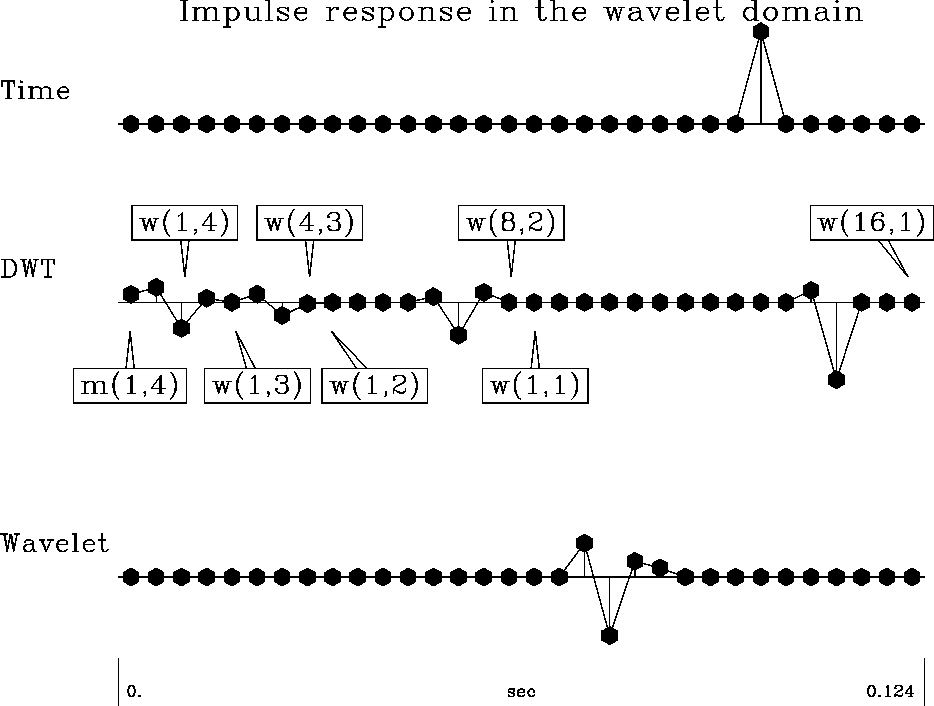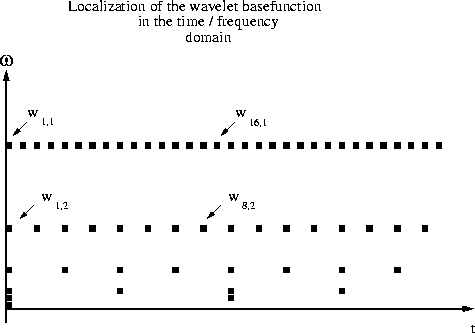The actual DWT is a recursion of the matrix multiplication described
in the preceding section.
The original vector B has the length N, which must be
a power of 2. Consequently, the first recursion filter C has
the dimension ![]() .
The even N/2 coefficients of the output
vector represent the local highpass details wt.
The odd coefficients represent the local lowpass averages mt.
The highpass coefficients
are stored in the final result vector. The N/2 odd coefficients mt,
which are the local lowpass averages, enter the next recursion.
.
The even N/2 coefficients of the output
vector represent the local highpass details wt.
The odd coefficients represent the local lowpass averages mt.
The highpass coefficients
are stored in the final result vector. The N/2 odd coefficients mt,
which are the local lowpass averages, enter the next recursion.
In the next recursion step, the matrix C has the dimensions
![]() . It operates entirely on the lowpass
averages of the previous step. Again, its detail coefficients are stored in
the output vector; its averages enter the next recursion step. Consequently,
the details wt and the averages mt are also called wavelet and mother
coefficients, respectively.
. It operates entirely on the lowpass
averages of the previous step. Again, its detail coefficients are stored in
the output vector; its averages enter the next recursion step. Consequently,
the details wt and the averages mt are also called wavelet and mother
coefficients, respectively.
When only two coefficients remain in the recursion, the recursion ends. These final two coefficients are averages of previous averages. They complete as top coefficients the final wavelet coefficient vector wt. Such a series of matrix multiplication and sorting is often referred to as a pyramidal or butterfly structure.
In the following diagram, the subscript of a subvector denotes the recursion of which it is a result. The subscript of each coefficient numbers pairs within the output of a particular recursion.
![\begin{displaymath}
\left[\matrix{
B_0 \cr B_1 \cr B_2 \cr B_3 \cr
B_4 \cr B_5...
...matrix{ w_0 \cr w_1 \cr w_2 \cr w_3 \cr }\right]_1
\end{array}\end{displaymath}](img5.gif) |
(3) |
The inverse DWT transform is performed by interleaving the top four coefficients of the wavelet domain vector, then multiplying them by the corresponding inverse matrix. Recursively applying the inverse operation of the forward matrix multiplication and separation yields the original input vector. The program dwtact.rt implements the recursion.
# #% subroutine dwtact(conj, dir, dat,n1,n2,n3, c,nop) integer conj, dir, n1,n2,n3, nop, n, i1,i2,i3 real dat(n1,n2,n3),c(nop)call cofi(dir,c,nop)
Do i3 = 1,n3 Do i2 = 1,n2 if(conj == 0){ n = n1 while( n >= 4 ){ call dwt(conj, dat((i2-1)*n1+(i3-1)*n2*n1 + 1,1,1) ,n, c,nop) n = n/2 } } else{ n = 4 while( n <= n1 ){ call dwt(conj, dat((i2-1)*n1+(i3-1)*n2*n1 + 1,1,1) ,n, c,nop) n = 2*n } } return; end
 |
|
loc
Figure 2 Localization of a base function in the frequency-time plane. Dots in the frequency-time plane represent the localization corresponding to a certain wavelet coefficient. Each horizontal line refers to coefficients of the same octave. The localization is idealized: the dot represents the first time sample of the filter whose length increases with frequency. The dot's ordinate represents the frequency peak of the filter. For example, an FFT transform would plot as a string of equally spaced dots along the |  |